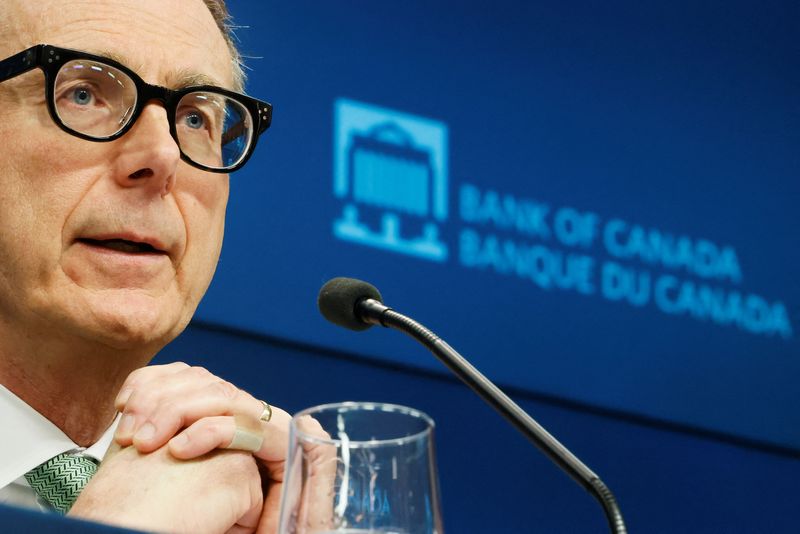By Steve Scherer
OTTAWA (Reuters) - The Bank of Canada (BoC) became the first major global central bank to pause its rate-hike campaign in January, but the economy's surprisingly strong performance since then will test Governor Tiff Macklem's resolve to stay on the sidelines this week.
A return to rate-hike mode would raise questions about how high the bank can take borrowing costs without sending the economy into a tail spin. Between March 2022 and January, the BoC hiked eight times to a 15-year high of 4.50% - the fastest tightening cycle in the bank's history.
Still the rapid rise in the price of money has failed to cool an overheating economy, with the first quarter GDP rising 3.1% - versus the 2.3% forecast by the BoC - and April seen expanding 0.2%. Nor has it loosened the tight labour market or tamed wage growth.
Inflation, which peaked at 8.1% last year, accelerated for the first time in 10 months in April to 4.4%, more than double the Bank of Canada's 2% target. The recent recovery in Canada's housing market is also putting pressure on prices, analysts say.
"Following the rapid turnaround in the housing market and upside surprise to CPI inflation in April, that resilience boosts the case for another interest rate hike, which we now judge to be more likely than not," said Stephen Brown, deputy chief North America economist at Capital Economics.
Strong household spending and exports drove growth in the first quarter.
The Bank of Canada will announce its interest rate decision at 10 a.m. ET (1400 GMT) on Wednesday.
Money markets see a nearly 40% for a 25-basis-point hike on Wednesday, a more than 80% chance for one by July, and they fully price one in by September..
Yet, about two-thirds of economists polled by Reuters last week expect the BoC to keep rates on hold for the rest of this year. Four said they see a hike on Wednesday and three-quarters said there is a risk of at least one increase in June or July.
U.S. JOBS DATA
The May unemployment rate in United States rose from a 53-year low to 3.7% in May, the biggest jump since April 2020. The easing of labor market conditions south of the border could allow the Federal Reserve to pause its own tightening campaign this month.
Since the United States accounts for about three-quarters of Canada's exports, indications of slowing growth there could play into Macklem's decision. But some analysts say Macklem could shrug off market expectations and protectively push rates higher.
"The Bank of Canada's penchant for surprising traders means that nothing can be ruled out," said Royce Mendes, head of macro strategy at Desjardins Group.
Mendes said there could be more than one rate hike in the cards, and Canadians should "brace themselves for a further tightening in financial conditions this summer".
The governing council discussed the possibility of raising rates at its last policy meeting in April, according to the minutes, and Macklem has repeatedly warned rates could go higher if inflation does not slow as expected to 3% this summer.
To definitively rule out further hikes, Macklem said the labour market must soften as growth slows, easing wage pressure and price-setting behavior by businesses, especially in the services sector.

So far, the data show this scenario is not playing out.
"The latest round of data adds weight to our view that the Bank will need to conduct an insurance rate hike at either of its next two meetings," said Jay Zhao-Murray, FX analyst at Monex Canada.